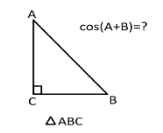
If $\vartriangle ABC$ is right angled at \[C\], then what is the value of \[cos\left( {A + B} \right)\]?
A. $0$
B. $1$
C. $\dfrac{1}{2}$
D. $\dfrac{{\sqrt 3 }}{2}$
Answer
566.7k+ views
Hint: From the question we have to find the value of required trigonometry relation. The given of the question is a triangle ABC with right angled at C. By using the angle sum property of a triangle we will get the value of addition of the required two angles. On substituting the value into the trigonometric relation we can get the required solution.
Angle sum property of a triangle states that the sum of all the angles of a triangle is $180^\circ $.
Complete step-by-step answer:

It is given that $\angle C$ is right angled in a $\vartriangle ABC$.
We already know that, angle sum property of a triangle states that the sum of all the angles of a triangle is $180^\circ $. By using the angle sum property of a triangle for $\vartriangle ABC$, we get,
$\angle A + \angle B + \angle C = 180^\circ $ (Angle sum property of a triangle)
And in the given of the question, where $\angle C = 90^\circ $
Substituting the value of \[C\] in the above equation and solving,
$\Rightarrow$$\angle A + \angle B + 90^\circ = 180^\circ $
Rearranging the terms to solve,
$\Rightarrow$$\angle A + \angle B = 180^\circ - 90^\circ $
Subtracting the term,
Hence,
$\Rightarrow$$\angle A + \angle B = 90^\circ $
Now we get the addition value of the $\angle A$ and $\angle B$
Now, we have to find the value of \[cos\left( {A + B} \right)\]
We will substitute this in \[cos\left( {A + B} \right)\]
$\Rightarrow$$ \Rightarrow \cos (A + B)$
As we have derived that $\angle A + \angle B = 90^\circ $, substituting this and by using $\cos (90^\circ ) = 0$ we get,
$ \Rightarrow \cos (90^\circ ) = 0$
The value of \[cos\left( {A + B} \right)\] is equal to 0.
Note: The vertex at which the triangle is making a right angle must be carefully observed as it is very important and can change the entire question. For example, if the triangle had been right angled at $A$, $\cos (B + C) = 90^\circ $. In this case, the answer would not have been the same.
Angle sum property of a triangle states that the sum of all the angles of a triangle is $180^\circ $.
Complete step-by-step answer:

It is given that $\angle C$ is right angled in a $\vartriangle ABC$.
We already know that, angle sum property of a triangle states that the sum of all the angles of a triangle is $180^\circ $. By using the angle sum property of a triangle for $\vartriangle ABC$, we get,
$\angle A + \angle B + \angle C = 180^\circ $ (Angle sum property of a triangle)
And in the given of the question, where $\angle C = 90^\circ $
Substituting the value of \[C\] in the above equation and solving,
$\Rightarrow$$\angle A + \angle B + 90^\circ = 180^\circ $
Rearranging the terms to solve,
$\Rightarrow$$\angle A + \angle B = 180^\circ - 90^\circ $
Subtracting the term,
Hence,
$\Rightarrow$$\angle A + \angle B = 90^\circ $
Now we get the addition value of the $\angle A$ and $\angle B$
Now, we have to find the value of \[cos\left( {A + B} \right)\]
We will substitute this in \[cos\left( {A + B} \right)\]
$\Rightarrow$$ \Rightarrow \cos (A + B)$
As we have derived that $\angle A + \angle B = 90^\circ $, substituting this and by using $\cos (90^\circ ) = 0$ we get,
$ \Rightarrow \cos (90^\circ ) = 0$
The value of \[cos\left( {A + B} \right)\] is equal to 0.
Note: The vertex at which the triangle is making a right angle must be carefully observed as it is very important and can change the entire question. For example, if the triangle had been right angled at $A$, $\cos (B + C) = 90^\circ $. In this case, the answer would not have been the same.
Recently Updated Pages
Two men on either side of the cliff 90m height observe class 10 maths CBSE

What happens to glucose which enters nephron along class 10 biology CBSE

Cutting of the Chinese melon means A The business and class 10 social science CBSE

Write a dialogue with at least ten utterances between class 10 english CBSE

Show an aquatic food chain using the following organisms class 10 biology CBSE

A circle is inscribed in an equilateral triangle and class 10 maths CBSE

Trending doubts
Why is there a time difference of about 5 hours between class 10 social science CBSE

Write a letter to the principal requesting him to grant class 10 english CBSE

What is the median of the first 10 natural numbers class 10 maths CBSE

The Equation xxx + 2 is Satisfied when x is Equal to Class 10 Maths

Which of the following does not have a fundamental class 10 physics CBSE

State and prove converse of BPT Basic Proportionality class 10 maths CBSE




